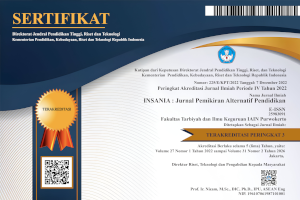Model Belajar Siswa Aktif Dengan Pendekatan Alsak (Al Qur’an, Sains Dan Karakter) Pada Pendidikan Anak Usia Dini Untuk Mewujudkan Generasi Emas Indonesia Tahun 2040
DOI:
https://doi.org/10.24090/insania.v20i1.1421Abstract
Abstract: The demographic bonus phenomenon that occurred in indonesia needs attention, especially from the goverment to carry out programs that empower human resources. Goverment strategic plan with mandates character education at all levels of education is the appropriate action to improve the quality of human resources. Many experts recommend that character education should be carried out character education from an early age. Therefore, learning in early childhood learning models require references oriented character education. ALSAK (al-Qur’an, science, and character) students’ active approach is the idea of learning-oriented model of character education. This model directs students to learn actively study the Qur’an and its meaning associated with scientific knowledge, and character. Based on the study of theory, learning model supporting the implementation of character education in early childhood. The success of the model of active student learning with ALSAK approach has not been tested empirically so as not to obtain information about the effectiveness of this model. Therefore, it is necessary to test the research in order to obtain full information about the increase of student character ECD by applying this model. Keywords: demographic bonus, early childhood education, active student learning model, ALSAK approachDownloads
Published
How to Cite
Issue
Section
License
Authors who publish with this journal agree to the following terms:
Authors retain copyright and grant the journal right of first publication with the work simultaneously licensed under a Creative CommonsAttribution-ShareAlike License that allows others to share the work with an acknowledgment of the work's authorship and initial publication in this journal.
Authors are able to enter into separate, additional contractual arrangements for the non-exclusive distribution of the journal's published version of the work (e.g., post it to an institutional repository or publish it in a book), with an acknowledgment of its initial publication in this journal.
Authors are permitted and encouraged to post their work online (e.g., in institutional repositories or on their website) prior to and during the submission process, as it can lead to productive exchanges, as well as earlier and greater citation of published work (See The Effect of Open Access).








